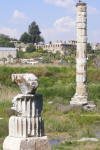




Home Turkey Istanbul Gallipoli Troy Pergamon Kusadasi Selcuk Priene Miletos Didyma Hierapolis Aphrodisias
Ephesus - Day 8 - Monday 9th May
We left the hotel at 9.00 am for an early start at Ephesus. The site gets very busy with tourist parties, particularly when cruise ships call at Kusadasi, and there were 2 in today. The day was warm and sunny. We started at the top of the site so were walking downhill all the time.
Ephesus was probably founded before 2000 BC on a bay where the River Menderes flowed into the sea. It came under various influences, the Ionians about 1100 BC and the Romans in 190 BC. The river and bay started to silt up and the lower levels of the city became uninhabitable, partly due to malaria. After Alexander the Great took the city in 283 BC one of his successors, Lysimachos, moved the city further up the hill away from the river and built defensive walls. During the Roman period the city became more important as a regional capital and many fine buildings that we see today were built. The local marble is very white and makes the ruins look very attractive.
Road into site, notice water pipes. A pile of clay pipes Plan of Agora, Stoa and Bouleuterion 2 Information boards
View across Agora and Stoa to Bouleuterion Information board Seating in Bouleuterion, notice detail by steps.
Prytaneum (Palace of the Council) Levent feeding the site cats Poppies were everywhere Nike, Goddess of Victory
Heracles Gate, entrance to Curetes Street Our tour straggling through the gate in front of them Curetes Street
Fountain of Trajan Terrace Houses A major area of current excavation [Top of Page]
The Varius Baths were established by about 50 AD and were later renovated by a christian lady named Scholastica. Her seated statue can still be seen in a niche in the entrance.
View towards the Library Information board and entrance to Temple of Hadrian (undergoing restoration)
The reconstructed Library of Celsus was built in 135 AD in honour of C Celsus, Governor of Asia Minor.

 To the right side of the
Library was the Gate of Mithrades which led into The Agora
To the right side of the
Library was the Gate of Mithrades which led into The Agora
Marble Street leads from the Library to the Theatre. The acoustics of the theatre were excellent.
Harbour Street leads from the Theatre down to the Harbour. It was lined either side with columns for all its 530 metres length. It was restored by the Emperor Arcadius in about 400 AD, so it was called Arcadian. The street was paved with marble and included a sewage system to dispose of waste. It was lit by street lamps. The area either side is a bit of a jumble as seen from the photo. It is thought there was a gymnasium, a church, an Agora and some baths in the surrounding area.
We next went to a traditional village, Sirince, where we had lunch in a Turkish restaurant. [Top of Page]


 Village
Elaine in Restaurant Some of our party
in restaurant
Village
Elaine in Restaurant Some of our party
in restaurant
After lunch we visited the Ephesus Museum in nearby Selcuk.
Demonstration of a Roman room corner 4 examples of Ionic column capitals, including a bull motif.
A Sarcophogus 2 statues of goddess Artemis A frieze with bull and swag motifs.
We went onto to see the remains of the Temple of Artemis in Selcuk


 .
Very little remains, the
single column was probably re-erected.
.
Very little remains, the
single column was probably re-erected.
The day finished with a visit to a leather factory? or outlet and a visit to a Turkish Delight outlet. [Top of Page]